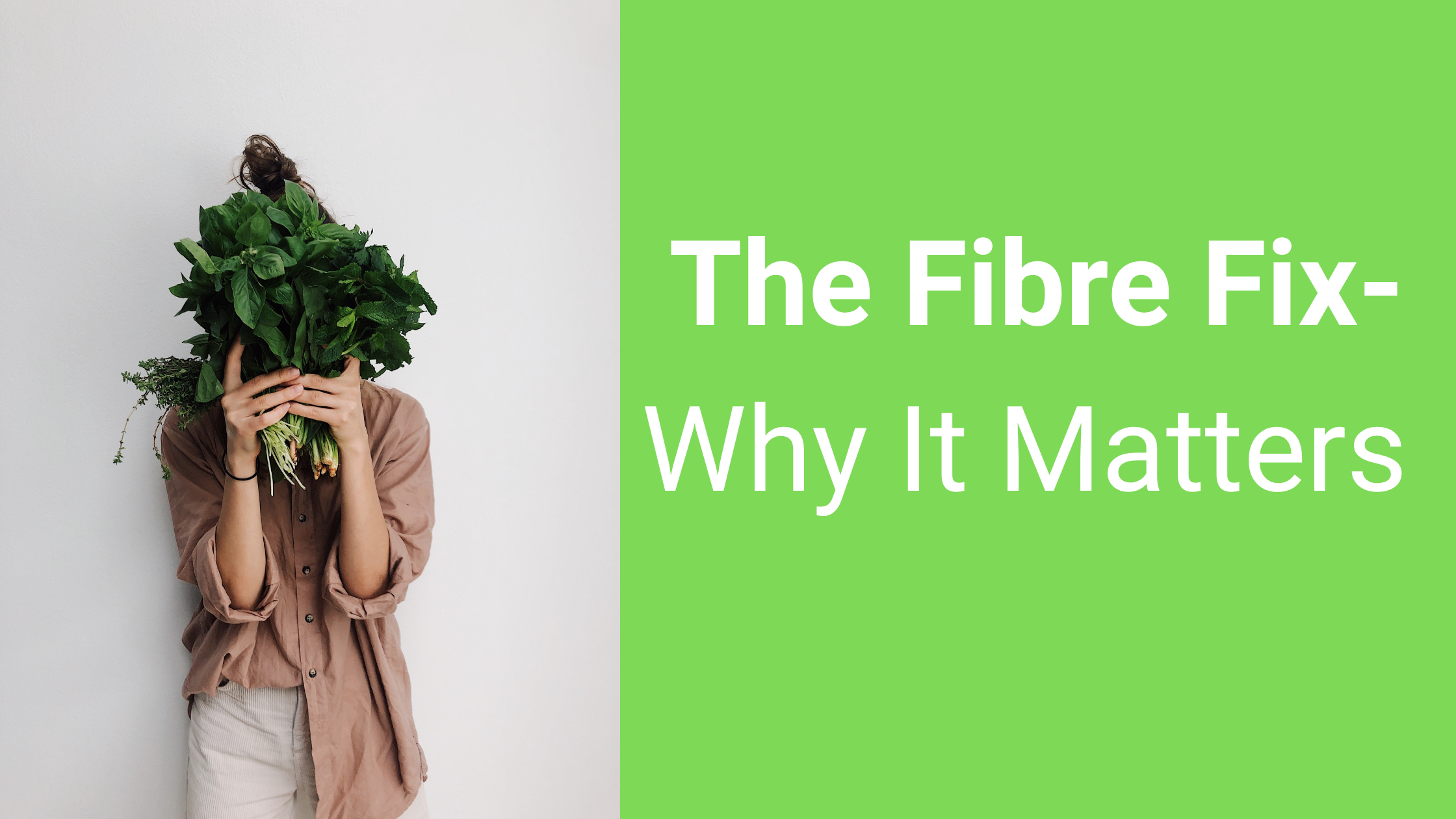Your basket is currently empty!
The Fibre Fix: Insoluble vs Soluble Fibre and Womens Health

- Insoluble vs Soluble Fibre
- What Exactly Is Insoluble vs Soluble Fibre —and Why Women Should Care?
- How Insoluble vs Soluble Fibre Benefit Hormones, Skin & Weight
- Signs You’re Not Getting Enough Fibre
- How Much Fibre Do Women Need?
- 6 Easy Ways to Increase Fibre Intake (Without Overhauling Your Diet)
- Insoluble vs Soluble Fibre and Gut Health: A Game-Changer for Women
- Where to Start if You’re New to Fibre Supplements
- Don't Forget: Insoluble vs Soluble Fibre Could Be Your Everyday Superpower
If you’re a woman over 30 struggling with bloating, tiredness, or weight that won’t budge—fibre might just be your secret weapon. You’ve probably heard fibre helps with digestion, but it does so much more. From regulating hormones to supporting weight management, fibre is essential for women—especially in their 30s, 40s and 50’s. Yet over 90% of adults don’t meet the UK fibre RDA [1]. In this article, we’ll explore why fibre is crucial, compare insoluble vs soluble fibre and how fibre supports your body as you age. Plus simple ways to get more fibre on a daily basis without completely overhauling your diet.
What Exactly Is Insoluble vs Soluble Fibre —and Why Women Should Care?
Fibre is the part of plant-based food your body can’t digest. It travels through your system, supporting digestion, blood sugar balance, and gut bacteria.
Dietary fibres are generally classified by their physicochemical properties such as their solubility, viscosity and fermentability.
Dietary fibres can be water-soluble or water-insoluble, with most plant foods containing a mixture of both.
- Soluble fibre: dissolves in water to form a gel that slows digestion, delay gastric emptying, decreasing glucose absorption, enhance immune function and lower cholesterol
- Approximately 20 per cent of consumed dietary fibre is soluble. Examples of soluble fibre include psyllium husk, glucomannan, oats, barley, flaxseed and in some fruits such as dried prunes, oranges, and grapefruit, barley, dried beans, and legumes
- Insoluble fibre: Insoluble fibres are important for increasing faecal bulk and stool softening (for easier movements) and decreasing bowel transit time
- Approximately 80 per cent of dietary fibre consumed is insoluble. Examples of insoluble fibre include wheat bran, nuts, seeds, skins of fruit and vegetables
Fibre also serves as a substrate for beneficial bacteria to feed on and there are certain fibres that are also prebiotic playing a vital role in feeding beneficial gut microbes.
Prebiotics are defined as “a substrate that is selectively utilised by host microorganisms conferring a health benefit”.
As up to 80% of immune cells and happy hormone serotonin are in the gut fibre is important for supporting immune function, hormone regulation, and mental health [2].
Whilst all prebiotics are fibre, not all fibres are prebiotic. The fermentability of dietary fibre varies greatly. For example, ranging from lignin not being prebiotic at all to pectin being almost complete fermentation.
Soluble fibres are fermented in the colon which results in the production of short-chain fatty acids (SCFAs). These in turn have anti-inflammatory effects in the gut, and help maintain intestinal barrier integrity. Insoluble fibres, whereas, are more slowly fermented.
Inulin and fructo-oligosaccharides (FOS) and GOS are well known prebiotic fibres. You can find these types of prebiotic fibres in wheat, chicory, garlic, onions, artichokes, asparagus and bananas. GOS are found in legumes such as lentils, beans, artichoke and in seaweed.
Other fibres such as cellulose, hemicellulose, pectin and lignins and resistant starches also provide important digestive benefits.
Cellulose is found in the cell wall of most plants, grains, fruits and vegetables.
Pectin is also found in plant cell walls and in the outer layers of fruit, such as apples, oranges and vegetables.
How Insoluble vs Soluble Fibre Benefit Hormones, Skin & Weight
Fibre is especially important for women over 30. Here’s how it helps:
Regulates estrogen: Fibre binds excess estrogen in the gut, helping excretion and preventing estrogen dominance [3].
Hormone regulation is especially important for women entering perimenopause when estrogen and progesterone levels start to fluctuate causing hormone imbalances.
Insoluble vs Soluble Fibre : The Type of Fibre Matters
The type of fibre, however, may matter. A study published in Science Direct looked at the effect of dietary fibre on serum estrogen concentrations in 62 premenopausal women.
They increased their daily dietary fibre intake from an average of ∼ 15 g to 30 g/d by supplementation with wheat, oat, or corn bran.
After 2 months on the high-fibre diets, the wheat-bran group showed significant reductions in serum estrone and estradiol. The serum estrogens were unaffected by dietary-fibre supplementation with oat or corn brans.
Balances blood sugar: High-fibre diets reduce insulin spikes, which affect energy and weight [4]
Supports satiety: Helps you feel full, leading to lower calorie intake [5]
Many women experience increased bloating, cravings, and weight gain during perimenopause—and fibre can be a natural ally in managing these.
Signs You’re Not Getting Enough Fibre
The NHS recommends at least 30g of fibre per day for adults, yet the average UK woman gets only around 17g [1].
Common signs of low fibre intake include:
- Constipation or irregularity
- Persistent bloating or gas
- Fatigue and brain fog
- Feeling hungry soon after meals
- Hormonal skin breakouts
- Difficulty losing weight
How Much Fibre Do Women Need?
According to the British Nutrition Foundation and NHS guidelines:
- Women should aim for 30g of fibre daily [1]
- This should include a combination of both Insoluble vs Soluble Fibre
- Most common foods provide 3–6g per serving
| Food | Fibre (approx.) |
| 1 apple (with skin) | 3–4g |
| ½ cup lentils | 8g |
| 2 slices wholemeal bread | 5g |
| 1 tbsp chia seeds | 5g |
It can be difficult to meet your fibre needs through diet alone, especially when busy – fibre pills and supplements can be a useful solution for many.
6 Easy Ways to Increase Fibre Intake (Without Overhauling Your Diet)
- Add 1 tbsp flax or chia seeds to yogurt or smoothies
- Swap white bread and pasta for wholegrain versions
- Include lentils, beans or chickpeas in weekly meals
- Keep the peel on your fruit & veggies where possible (eg potato peels are known sources of dietary fibre, so much so that it doubles if the peel is consumed)
- Eat more high-fibre fruits (e.g., pears, raspberries, apples)
- Use a prebiotic fibre supplement designed for women
Start slowly and increase water intake as your fibre goes up.

Insoluble vs Soluble Fibre and Gut Health: A Game-Changer for Women
Your gut contains trillions of bacteria—known as your gut microbiome—that influence everything from immunity to mood to weight regulation.
Prebiotic fibres (such as inulin or galacto-oligosaccharides) feed these good bacteria, increasing beneficial strains like Bifidobacteria and Lactobacilli [6].
A study published in Cell Host & Microbe found that dietary fibre was the single most important factor in improving microbiome diversity [6].
Where to Start if You’re New to Fibre Supplements
If increasing fibre through food feels unrealistic, or you’re simply not a fibre fan (because not everyone is) consider a low-dose, (or powder formula where you control the dose), UK fibre supplement that contains:
- Pectins or Prebiotic fibres like inulin
- Sugar Beet Fibre this adds bulk to stools for easier movements
- No added sugars or artificial ingredients
- A blend of soluble and insoluble fibre
Start with 1–2g and build up gradually over 1–2 weeks whilst listening to your body.
Studies indicate that small increases in daily fibre content, as low as 6–8 g of wheat fibre per day may mediate changes to microbiota composition.
Don’t Forget: Insoluble vs Soluble Fibre Could Be Your Everyday Superpower
If you’re tired, bloated, and just feel “off,” it could be down to low fibre. From gut balance to clearer skin and better energy, this one simple change could make a huge difference to how you feel daily. Start increasing and see for yourself.
Frequently Asked Questions
Insoluble vs Soluble Fibre
How Much Fibre Do I Need?
The NHS recommends at least 30g of fibre per day for adults, yet the average UK woman gets only around 17g.
What are the signs of not getting enough fibre?
Constipation or irregularity
Persistent bloating or gas
Fatigue and brain fog
Feeling hungry soon after meals
Hormonal skin breakouts
Difficulty losing weight
Sources of Insoluble vs Soluble Fibre ?
Soluble fibre: dissolves in water to form a gel that slows digestion, such as psyllium husk, glucomannan, oats and flaxseeds.
Insoluble fibre: adds bulk to stools to keep things moving, examples include wheat bran, nuts, seeds, skins of fruit and vegetables
Can I Increase Fibre with Fibre Pills?
Yes, fibre pills and supplements are a useful solution to help top up any gaps in the diet to help meet the fibre RDA.
Fibre Tablets
High fibre pills derived from psyllium husk, flaxseed, sugar beet, prune juice, fig fruit, rhubarb, pectin, fenugreek and other naturally high fibre botanicals and foods. More than just roughage, these fibre pills contains cellulose, pectin, hemicellulose, lignin and gums.
Fibre Pills Ingredients: Psyllium Husk, Flaxseed, Sugar Beet Fibre, Fenugreek, Apple pectin, Rhubarb, Prune Juice, Broccoli, Carrot, Fig Fruit, Fennel Seed. Vegan, Dairy Free, Gluten Free. 100 capsules
Psyllium Husk
Fibre Full blend with Psyllium Husk powder; Glucomannan; Sugar Beet; L-Glutamine; Inulin (FOS); Fennel Seed; Peppermint Leaf; Ginger Root; Bacteria blend, Lactobacillus Acidophilus, Bifidobacterium Bifidum; Sweetener, Stevia Leaf extract – No Artificial Sweeteners
Insoluble vs Soluble Fibre References & Studies
- Public Health England (2021). NDNS Results: Average fibre intake in the UK.
- Gill SK et al. (2021). Dietary fibre and the human gut microbiome. Nutrients.
- Goldin BR et al. (1982). The effect of dietary fibre on estrogen metabolism. J Natl Cancer Inst.
- Weickert MO & Pfeiffer AF (2008). Metabolic effects of dietary fibre consumption. Curr Opin Clin Nutr.
- Slavin JL (2005). Dietary fibre and body weight. Nutrition.
- Sonnenburg ED et al. (2016). Diet-induced extinctions in the gut microbiota compound over generations. Cell Host Microbe.
- King DE et al. (2007). Dietary fibre intake and markers of inflammation in the US adult population. Am J Clin Nutr.
- High-fiber diet reduces serum estrogen concentrations in premenopausal women – ScienceDirect
- Reference values for intake of six types of soluble and insoluble fibre in healthy UK inhabitants based on the UK Biobank data – PubMed



